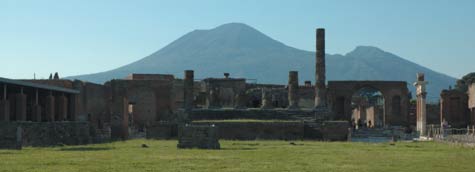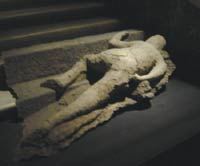|
« previous 16 of 38 next » | |||
Seventeen years later, on August 24th, in the year 79 A.D., Mount Vesuvius erupted quickly and violently. The first eruptions spewed so many hard sponge-like pumice stones into the air that they piled up on the ground at the rate of six inches per hour. The pumice stones were up to three inches in size but they were porous and light so they were not too dangerous. But, mixed in with the shower of pumice were some chunky pieces of lava that were heavy and could knock you out or kill you. Melted rock, or molten, is called “magma” when it is inside the Earth. This same molten rock is called “lava” when it reaches the surface of the Earth. Usually magma reaches the surface through a volcano. Most of the people fled the city of Pompeii during these first hours, some holding pillows to protect their heads. But a large number, estimated at 2,000 to 3,000 people, chose to stay. Later the same day, Vesuvius erupted even more dramatically than before. A huge column of burning ash, gas and rock exploded into the air next to the city. It is calculated that burning debris shot 20 miles directly up into the sky, a total of one cubic mile of ash in just 19 hours.  |
|||
